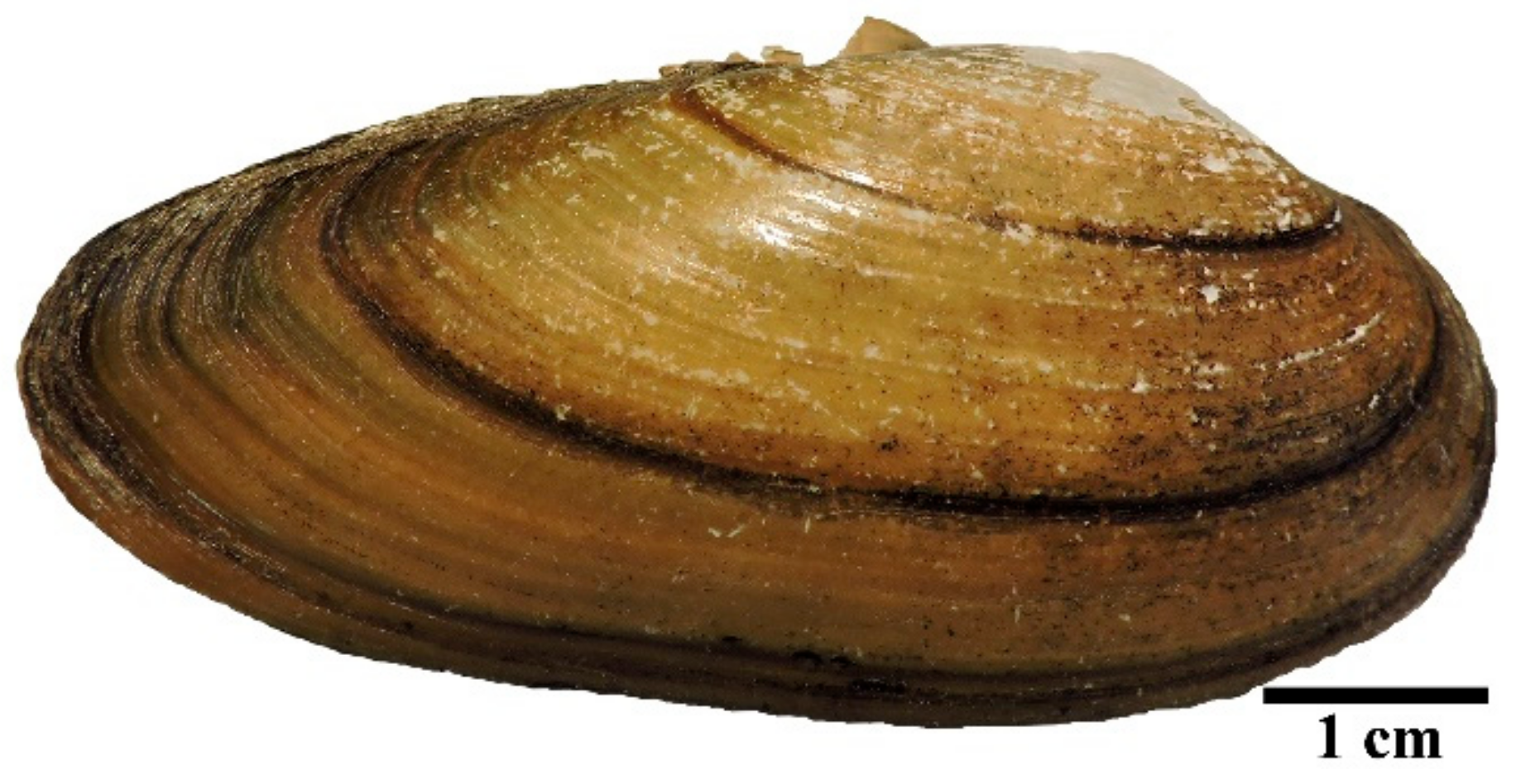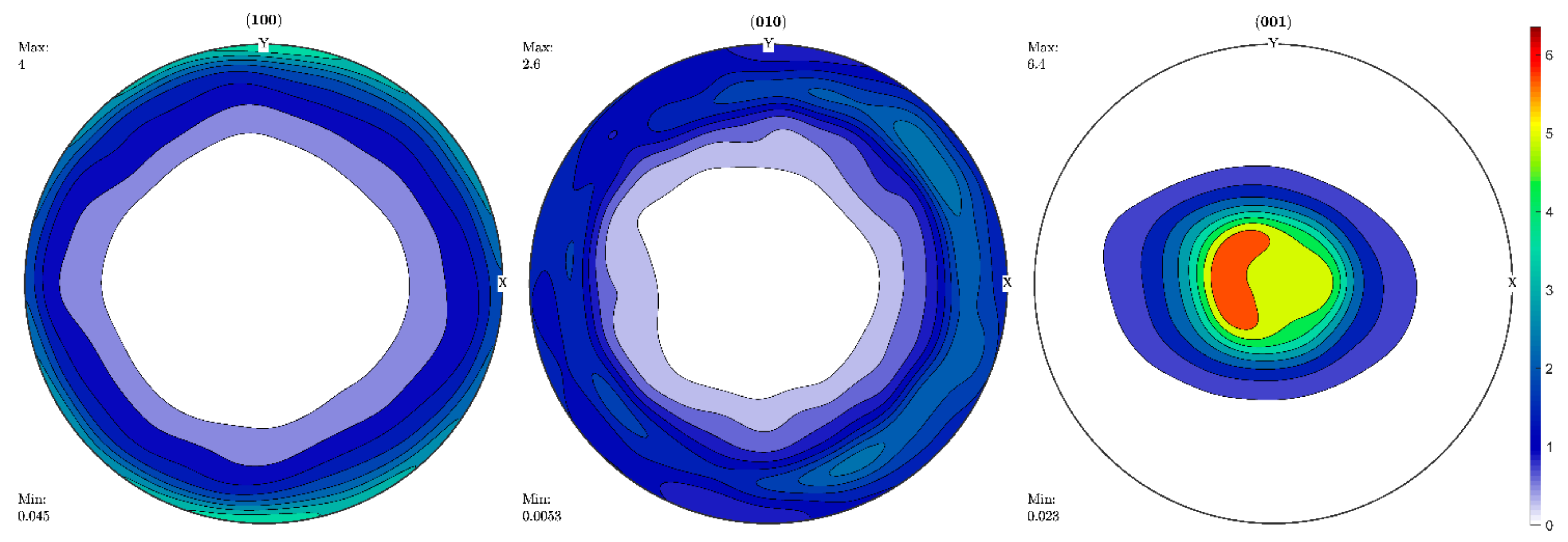Global Crystallographic Texture of Freshwater Bivalve Mollusks of the Unionidae Family from Eastern Europe Studied by Neutron Diffraction
Abstract
1. Introduction
2. Materials and Methods
2.1. Climatic Conditions and Salinity in the Habitats of the Studied Mollusks
2.2. Crystallographic Texture Analysis of Shells’ Minerals
3. Results


4. Discussion

5. Conclusions
Author Contributions
Funding
Institutional Review Board Statement
Informed Consent Statement
Data Availability Statement
Conflicts of Interest
References
- Zhadin, V.I. Family Unionidae. Fauna of the USSR, Mollusks; Publishing House of the Academy of Sciences of the USSR: Moscow, Russia, 1938; Volume 4, 170p. [Google Scholar]
- Alekhina, G.P.; Misetov, I.A. Filtration characteristics of freshwater bivalve mollusks of the Unionidae family in the middle reaches of the Ural River. Vestnik OSU 2013, 10, 34–36. [Google Scholar]
- Bunge, H.J. Texture Analysis in Material Science. Mathematical Methods; Butterworths Publ.: London, UK, 1982; 595p. [Google Scholar]
- Wasserman, G.; Greven, I. Textures of Metallic Materials; Metallurgy: Moscow, Russia, 1969; 653p. [Google Scholar]
- Matthies, S.R.; Vinel, G.W.; Helming, K. Standard Distributions in Texture Analysis; Akademie-Verlag: Berlin, Germany, 1987; Volume 1–3. [Google Scholar]
- Feldman, K. Texture Investigation by Neutron Time-of-Flight Diffraction. Textures Microstruct. 1989, 10, 309–323. [Google Scholar] [CrossRef]
- Brokmeier, H.-G. Neutron Diffraction Texture Analysis of Multi-Phase Systems. Textures Microstruct. 1989, 10, 325–346. [Google Scholar] [CrossRef]
- Dahms, M.; Bunge, H.J. A Positivity Method for Determination of Complete ODF. Textures Microstruct. 1988, 10, 21–35. [Google Scholar] [CrossRef]
- Lychagina, T.A.; Brokmeier, H.-G. Some practical results for calculating elastic properties of textured cubic polycrystals. Phys. Status Solidi A 2001, 184, 373–380. [Google Scholar] [CrossRef]
- Lychagina, T.A.; Nikolayev, D.I. Influence of the Texture on the AL-6%Mg Alloy Deformation. Textures Microstruct. 1999, 33, 111–123. [Google Scholar] [CrossRef]
- Lychagina, T.A.; Brokmeier, H.-G. Practical aspects of calculating elastic properties of textured hexagonal polycrystals. In Proceedings of the Twelfth International Conference on Textures of Materials (ICOTOM-12), Montreal, QC, Canada, 9–13 August 1999; Szpunar, J.A., Ed.; NRC Research Press: Ottawa, QC, Canada, 1999; Volume 1, pp. 541–546. [Google Scholar]
- Lychagina, T.A.; Nikolayev, D.I.; Sanin, A.F.; Tatarko, J.; Ullemeyer, K. Investigation of wheel steel crystallographic texture changes due to modification and thermo-mechanical treatment. IOP Conf. Ser. Mater. Sci. Eng. 2015, 82, 012107. [Google Scholar] [CrossRef]
- Frýda, J.; Klicnarová, K.; Frýdová, B.; Mergl, M. Variability in the crystallographic texture of bivalve nacre. Bull. Geosci. 2010, 85, 645–662. [Google Scholar] [CrossRef][Green Version]
- Ouhenia, S.; Chateigner, D.; Belkhir, M.A.; Guilmeau, E. Microstructure and crystallographic texture of Charonia lampas lampas shell. J. Struct. Biol. 2008, 163, 175–184. [Google Scholar] [CrossRef]
- Chateigner, D.; Kaptein, R.; Dupont-Nivet, M. X-ray quantitative texture analysis on Helix aspersa aspera (Pulmonata) shells selected or not for increased weight. Am. Malacol. Bull. 2009, 27, 157–165. [Google Scholar] [CrossRef]
- Almagro, I.; Drzymała, P.; Berent, K.; Saínz-Díaz, C.I.; Willinger, M.G.; Bonarsky, J.; Checa, A.G. New crystallographic relationships in biogenic aragonite: The crossed-lamellar microstructures of mollusks. Cryst. Growth Des. 2016, 16, 2083–2093. [Google Scholar] [CrossRef]
- Hahn, S.; Rodolfo-Metalpa, R.; Griesshaber, E.; Schmahl, W.W.; Buhl, D.; Hall-Spencer, J.M.; Baggini, C.; Fehr, K.T.; Immenhauser, A. Marine bivalve shell geochemistry and ultrastructure from modern low pH environments: Environmental effect versus experimental bias. Biogeosciences 2012, 9, 1897–1914. [Google Scholar] [CrossRef]
- Fitzer, S.C.; Phoenix, V.R.; Cusack, M.; Kamenos, N.A. Ocean acidification impacts mussel control on biomineralization. Sci. Rep. 2014, 4, 6218. [Google Scholar] [CrossRef] [PubMed]
- Dedu, I.I. Ecological Encyclopedic Dictionary; The Main Edition of the Moldavian Soviet Encyclopedia: Chisinau, Moldova, 1989; 406p. [Google Scholar]
- Dobrovolskiy, A.D.; Zalogin, B.S. Sea of the USSR; Moscow State University Publishing House: Moscow, Russia, 1982; 192p. [Google Scholar]
- Gerasimov, I.P. (Ed.) Physical and Geographical Atlas of the World; Academy of Sciences of the USSR and the Main Directorate of Geodesy and Cartography of the State Geological Committee of the USSR: Moscow, Russia, 1964; 298p. [Google Scholar]
- Li, S.; Liu, C.; Huang, J.; Liu, Y.; Zheng, G.; Xie, L.; Zhang, R. Interactive effects of seawater acidification and elevated temperature on biomineralization and amino acid metabolism in the mussel Mytilus edulis. J. Exp. Biol. 2015, 218, 3623–3631. [Google Scholar] [CrossRef] [PubMed]
- Nekhoroshkov, P.; Zinicovscaia, I.; Nikolayev, D.; Lychagina, T.; Pakhnevich, A.; Yushin, N.; Bezuidenhout, J. Effect of the elemental content of shells of the bivalve mollusks (Mytilus galloprovincialis) from Saldanha Bay (South Africa) on their crystallographic texture. Biology 2021, 10, 1093. [Google Scholar] [CrossRef] [PubMed]
- Pakhnevich, A.; Nikolaev, D.; Lychagina, T. Comparison of the Crystallographic Texture of the Recent, Fossil and Subfossil Shells of Bivalves. Paleontol. J. 2021, 55, 589–599. [Google Scholar] [CrossRef]
- Nikolaev, D.; Lychagina, T.; Pakhnevich, A. Experimental neutron pole figures of minerals composing the bivalve mollusc shells. SN Appl. Sci. 2019, 1, 344. [Google Scholar] [CrossRef]
- Nikolayev, D.I.; Lychagina, T.A.; Nikishin, A.V.; Yudin, V.V. Investigation of measured pole figures errors. Mater. Sci. Forum 2005, 495–497, 307–312. [Google Scholar] [CrossRef]
- Chateigner, D.; Hedegaard, C.; Wenk, H.-R. Mollusc shell microstructures and crystallographic textures. J. Struct. Geol. 2000, 22, 1723–1735. [Google Scholar] [CrossRef]
- Kucerakova, M.; Rohlicek, J.; Vratislav, S.; Nikolayev, D.; Lychagina, T.; Kalvoda, L.; Douda, K. Texture Study of Sinanodonta woodiana Shells by X-ray Diffraction. J. Surf. Investig. X-ray Synchrotron Neutron Tech. 2021, 15, 640–643. [Google Scholar] [CrossRef]
- Bachmann, F.; Hielscher, R.; Schaeben, H. Texture Analysis with MTEX-Free and Open Source Software Toolbox. Solid State Phenom. 2010, 160, 63–68. [Google Scholar] [CrossRef]




Publisher’s Note: MDPI stays neutral with regard to jurisdictional claims in published maps and institutional affiliations. |
© 2022 by the authors. Licensee MDPI, Basel, Switzerland. This article is an open access article distributed under the terms and conditions of the Creative Commons Attribution (CC BY) license (https://creativecommons.org/licenses/by/4.0/).
Share and Cite
Pakhnevich, A.; Nikolayev, D.; Lychagina, T.; Balasoiu, M.; Ibram, O. Global Crystallographic Texture of Freshwater Bivalve Mollusks of the Unionidae Family from Eastern Europe Studied by Neutron Diffraction. Life 2022, 12, 730. https://doi.org/10.3390/life12050730
Pakhnevich A, Nikolayev D, Lychagina T, Balasoiu M, Ibram O. Global Crystallographic Texture of Freshwater Bivalve Mollusks of the Unionidae Family from Eastern Europe Studied by Neutron Diffraction. Life. 2022; 12(5):730. https://doi.org/10.3390/life12050730
Chicago/Turabian StylePakhnevich, Alexey, Dmitry Nikolayev, Tatiana Lychagina, Maria Balasoiu, and Orhan Ibram. 2022. "Global Crystallographic Texture of Freshwater Bivalve Mollusks of the Unionidae Family from Eastern Europe Studied by Neutron Diffraction" Life 12, no. 5: 730. https://doi.org/10.3390/life12050730
APA StylePakhnevich, A., Nikolayev, D., Lychagina, T., Balasoiu, M., & Ibram, O. (2022). Global Crystallographic Texture of Freshwater Bivalve Mollusks of the Unionidae Family from Eastern Europe Studied by Neutron Diffraction. Life, 12(5), 730. https://doi.org/10.3390/life12050730





